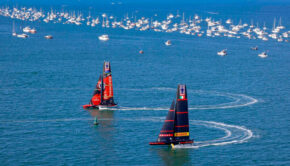America’s Cup: For the glass half full crowd
Published on December 16th, 2013
The City of San Francisco has a big decision to make. After organizers assured the City the 34th America’s Cup would not need taxpayer funds, politicians have learned that assessment was wrong by about 5.5 million dollars. And now the City must submit their bid to host the 35th edition.
Is it worth the risk? This editorial by the SF Chronicle thinks so…
Crunch the numbers for the America’s Cup race, and the figures aren’t impressive: fewer fans than predicted, a smaller haul for the economy and a $5.5 million city expense. But the race can still be counted as an overall financial boost and public event that added to San Francisco’s global luster.
The final tab amounts to a loss for the city’s public ledger, a fact that stings after numerous pledges that the three-month yachting contest would break even. But the expense should be matched against other factors, some measurable – upgraded waterfront, short-term jobs, infusion of tourist dollars – and others harder to calculate, such as public enjoyment, worldwide attention and a sense of civic accomplishment.
The totals are fueling a told-you-so debate with both critics and supporters of the regatta finding evidence for their beliefs. Mayor Ed Lee, a race supporter, is due to produce a preliminary bid for the next America’s Cup, scheduled for August 2017, and the latest financials are sure to figure in the paperwork proposal and future public approvals.
The bubbly predictions of $1.4 billion in economic spinoffs and 2.7 million spectators proved far too high. In the latest totals, there were $550 million in financial benefits and 700,000 race watchers. Sports economics, it’s fair to say, is an inexact science.
But there are reasons for this downward curve, not all the fault of race promoters or naive civic leaders. The $100 million cost of race preparations for each boat during a global economic slowdown trimmed the field from a predicted 15 to four entries. In turn, that drew fewer tourists to fill hotels and restaurants. A big race became smaller, making it harder to raise private money that was over-promised as well.
San Francisco still sails away a winner. A walled-off waterfront was opened for public use at race headquarters on Piers 27 and 29. Bike routes and walkways were upgraded. Public space was revived and improved in inviting and permanent ways. Gorgeous scenes of the races offered an extended infomercial for both the sport and Bay Area tourism.
Should the next America’s Cup take place here, the lessons of last summer’s contest should be studied and heeded.
Costs and economic benefits need to be weighed skeptically. Race organizers need to bear more of the cost and the risk. Public expectations should be tempered.
The city’s sponsorship of the Cup wasn’t cheap, but it was worth doing, and it will be worth doing better next time – with lessons learned.
Source: SF Chronicle









 We’ll keep your information safe.
We’ll keep your information safe.